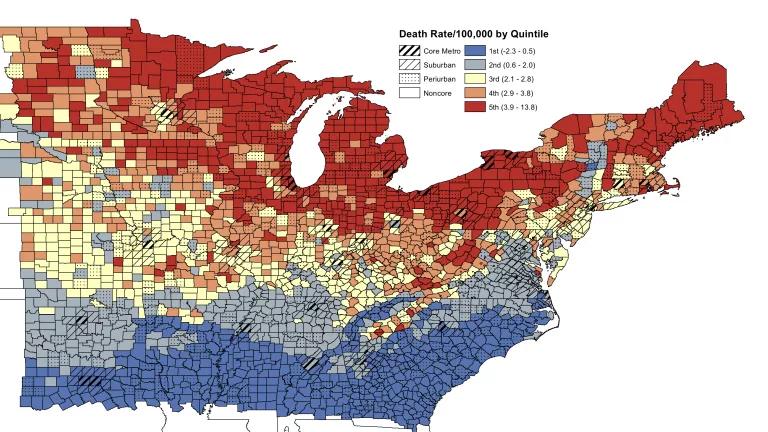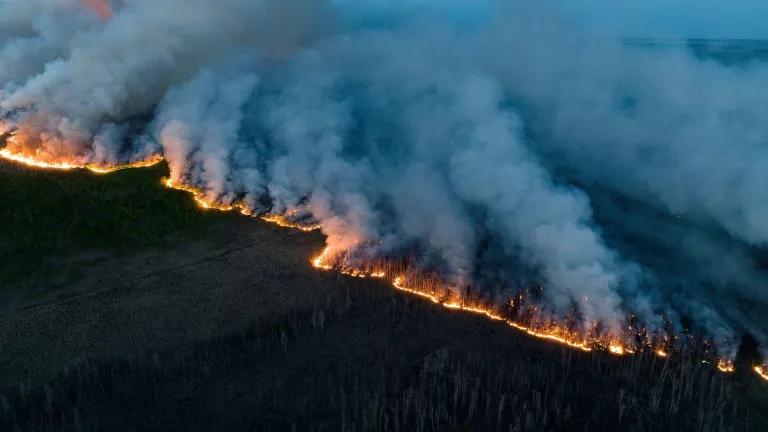Punishing Heat in the East: Climate Change and Heat Stress

The eastern US continues to grapple with extreme heat this week, with New York City under a National Weather Service Heat Advisory through tonight. Heat index values could reach 104°F, and residents are warned about the substantial health risks that this especially warm weather brings, especially amongst populations that cannot stay cool by using air conditioning or accessing a neighborhood cooling center. This latest heat wave follows a string of punishing heat that has swamped many parts of the US (and the world) this summer, and new research shows that climate change could cause thousands of heat-related deaths if we do not act to stem the problem.
A new study published in EcoHealth, which I led, puts this week’s extreme heat into context and looks forward to quantify how climate change could make future summers unbearably hot and cause thousands of deaths due to heat stress in much of the US. Our study integrated state-of-the-science climate and public health models to quantify how the increasing concentration of greenhouse gases in the atmosphere could affect summer temperatures across a wide swath of the US, and how warmer future summers put millions of Americans at greater risk of death from heat stress, which also causes an array of other bad health effects.
Our results are sobering. We calculated that, without strong action to curb emissions of greenhouse gases that drive climate change, a business-as-usual emissions scenario would mean that average apparent summer temperatures (incorporating the effects of both heat and humidity) in the eastern US could increase by 4.5°C (8.1°F) by the middle of the century compared to the present-day. Minimum summer temperatures, which are important indicators of our ability to dissipate heat overnight, increase by 3.3°C (5.7°F). These substantial increases in summer temperatures have major consequences for public health. We calculated that, as a result of more frequent exposures to extreme heat, up to 11,500 Americans could die from extreme heat exposures each year by the middle of the century.
The map above shows our calculated change in the heat-related mortality rate per 100,000 people from present-day to mid-century for all age groups. Mortality rates were calculated using an EPA health impact model, BenMAP, at the county level and stratified by county urbanization level.
This work also sheds light on disproportionate vulnerability certain people to the health effects of extreme heat. For people living in cities, where the urban heat island effect can exacerbate already extremely hot temperatures, the risks are substantial. In our study, highly urbanized counties experienced higher average summer temperatures by mid-century compared to rural counties. The relative increases in average summer temperature were about 1°C warmer in urban counties compared to rural counties.
Elderly populations are also particularly vulnerable to heat stress-related early death. In this work, we estimated that the increase in overall heat-related mortality rates due to extreme heat about ten times higher for the elderly population aged 65 or greater compared to the population-at-large. Our study follows up on a related investigation that documented the unintended side-effects of summertime air conditioning in the same region, which helps to relieve exposures to extreme heat but worsens emissions of some of the most dangerous kinds of air pollution. While this research study did not explore occupational risks for people who work outdoors, the science shows that these workers are in need of enhanced protections from extreme heat.
This week’s heat wave is a reminder that the time to act on climate change is now: 2017 was one of the hottest years on record and extremely hot days are becoming more intense and frequent worldwide. While measures to adapt to a warmer world can help to reduce the impact of high temperatures, we also need to enact aggressive policies that shift our country away from dirty fuels towards cleaner energy sources. As this work shows, strong action on climate change could save thousands of lives.



